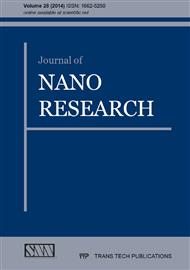[1]
C.G. Granqvist, Oxide electrochromics: An introduction to devices and materials, Sol. Energy Mater. Sol. Cells 99 (2012) 1-13.
Google Scholar
[2]
C.G. Granqvist, P.C. Lanaker. N. R. Mlyuka, G.A. Niklasson, E. Avendaño, Progress in chromogenics: New results for electrochromic and thermochromic materials and devices, Sol. Energy Mater. Sol. Cells 93 (2009) 2032-2039.
DOI: 10.1016/j.solmat.2009.02.026
Google Scholar
[3]
S.V. Green, M. Watanabe, N. Oka, G.A. Niklasson, C.G. Granqvist, Y. Shigesato, Electrochromic properties of nickel oxide based thin films sputter deposited in the presence of water vapor, Thin solid films 520 (2012) 3839-3842.
DOI: 10.1016/j.tsf.2011.08.030
Google Scholar
[4]
I. Bouessay, A. Rougier, P. Poizot, J. Moscovici, A. Michalowicz, J.-M. Tarascon, Electrochromic degradation in nickel oxide thin film: A self-discharge and dissolution phenomenon, Electrochim. Acta 50 (2005) 3737-3745.
DOI: 10.1016/j.electacta.2005.01.020
Google Scholar
[5]
R. Cerc-Korošec, P. Bukovec, The role of thermal analysis in optimization of the electrochromic effect of nickel oxide thin films, prepared by the sol–gel method: Part II, Thermochim. Acta 410 (2004) 65-71.
DOI: 10.1016/s0040-6031(03)00373-3
Google Scholar
[6]
S.H. Lin, F.R. Chen, J.J. Kai, Electrochromic properties of nano-structured nickel oxide thin film prepared by spray pyrolysis method, Applied Surface Science 254 (2008) 2017–2022.
DOI: 10.1016/j.apsusc.2007.08.029
Google Scholar
[7]
K. Nakaoka, J. Ueyama, K. Ogura, Semiconductor and electrochromic properties of electrochemically deposited nickel oxide films, J. Electroanal. Chem. 571 (2004) 93-99.
DOI: 10.1016/j.jelechem.2004.05.003
Google Scholar
[8]
D.S. Dalavi, M.J. Suryavanshi, D.S. Patil, S.S. Mali, A.V. Moholkar, S.S. Kalagi, S.A. Vanalkar, S.R. Kang, J.H. Kim, P.S. Patil, Nanoporous nickel oxide thin films and its improved electrochromic performance: Effect of thickness, Applied Surface Science 257 (2011) 2647–2656.
DOI: 10.1016/j.apsusc.2010.10.037
Google Scholar
[9]
P. Oliva, J. Leonardi, J. F. Laurent, C. Delmas, J. J. Braconnier, M. Fligarz, F. Fievet, A. de Guibert, Review of the structure and the electrochemestry of nickel hydroxides and oxy-hydroxides, J. Power Sources 8 (1982) 229.
DOI: 10.1016/0378-7753(82)80057-8
Google Scholar
[10]
A. Delahaye-Vidal, B. Beaudoin, N. Sac-Epée, K. Tekaia-Elhsissen, A. Audemer, M. Figlarz, Structural and textural investigations of the nickel hydroxide electrode, Solid State Ionics, 84 (1996) 239.
DOI: 10.1016/0167-2738(96)00030-6
Google Scholar
[11]
W. K. Hu, D. Noréus, Alpha nickel hydroxides as lightweight nickel electrode materials for alkaline rechargeable cells, Chem. Mater. 15 (2003) 974-978.
DOI: 10.1021/cm021312z
Google Scholar
[12]
A. Mendoza-Galván, M.A. Vidales-Hurtado, Electrochromic nickel oxide-based thin films deposited by chemical bath, Trans Tech Publications, 55 (2008) 24-29.
Google Scholar
[13]
M.A. Vidales-Hurtado, A. Mendoza-Galván, Electrochromism in nickel oxide-based thin films obtained by chemical bath deposition, Solid State Ionics, 179 (2008) 2065-2068.
DOI: 10.1016/j.ssi.2008.07.003
Google Scholar
[14]
R.M. Torresi, M.V. Vázquez, A. Gorenstein, S.I. Córdoba de Torresi, Infrared characterization of electrochromic nickel hydroxide prepared by homogeneous chemical precipitation, Thin Solid Films 229 (1993) 180-186.
DOI: 10.1016/0040-6090(93)90361-r
Google Scholar
[15]
M.A. Vidales-Hurtado, A. Mendoza-Galván, Optical and structural characterization of nickel oxide-based thin films obtained by chemical bath deposition, Mater. Chem. Phys. 107 (2008) 33-38.
DOI: 10.1016/j.matchemphys.2007.06.036
Google Scholar
[16]
W.K. Hu, X.P. Gao, D. Noréus, T. Burchardt, N. K. Nakstad, Evaluation of nano-crystal sized α-nickel hydroxide as an electrode material for alkaline rechargeable cells, Journal of Power Sources 160 (2006) 704–710.
DOI: 10.1016/j.jpowsour.2006.01.048
Google Scholar
[17]
Y. Luo, G. Duan, G. Li, Synthesis and characterization of flower-like β-Ni(OH)2 nanoarchitectures, Journal of Solid State Chemistry 180 (2007) 2149–2153.
DOI: 10.1016/j.jssc.2007.05.025
Google Scholar
[18]
J. Ederth, P. Johnsson, G. A. Niklasson, A. Hoel, A. Hultaker, P. Heszler, C. G. Granqvist, A. R. van Doorn, M. J. Jongerius, D. Burgard, Electrical and optical properties of thin films consisting of tin-doped indium oxide nanoparticles, Physical Review B 68 (2003) 155410-1.
DOI: 10.1103/physrevb.68.155410
Google Scholar
[19]
R. Kostecki, F. McLarnon, Electrochemical and in situ Raman spectroscopic characterization of nickel hydroxide electrodes, J. Electrochem. Soc. 144 (1997) 485-493.
DOI: 10.1149/1.1837437
Google Scholar
[20]
F.P. Kober, Analysis of the charge-discharge characteristics of nickel-oxide electrodes by infrared spectroscopy, J. Electrochem. Soc. 112 (1965) 1064-1067.
DOI: 10.1149/1.2423361
Google Scholar
[21]
G.A. Niklasson, C.G. Granqvist, Electrochromics for smart windows: thin films of tungsten oxide and nickel oxide, and devices based on these, J. Mater. Chem. 17 (2007) 127-156.
DOI: 10.1039/b612174h
Google Scholar
[22]
A. Al-Kahlout, M.A. Aegerter, Coloration mechanisms of sol–gel NiO–TiO2 layers studied by EQCM, Sol. Energy Mater. Sol. Cells 91 (2007) 213–223.
DOI: 10.1016/j.solmat.2006.08.003
Google Scholar
[23]
S.I. Cordoba-Torresi, A. Hugot-Le Goff, S. Joiret, Electrochromic behavior of nickel oxide electrodes: II. Identification of the bleached states by Raman spectroscopy and nuclear reactions, J. Electrochem. Soc. 138 (1991) 1554-1559.
DOI: 10.1149/1.2085831
Google Scholar
[24]
Y.L. Lo, B.J. Hwang, In situ Raman studies on cathodically deposited nickel hydroxide films and electroless Ni-P electrodes in 1 M KOH solution, Langmuir 14 (1998) 944-950.
DOI: 10.1021/la9600255
Google Scholar
[25]
C. Johnston, P.R. Graves, In situ Raman spectroscopy study of the nickel oxyhydroxide electrode (NOE) system, Appl. Spectrosc. 44 (1990) 105-115.
DOI: 10.1366/0003702904085769
Google Scholar


